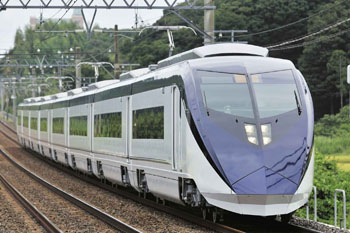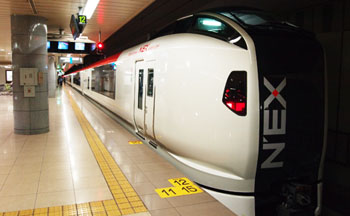
Keisei Electric Railway ‘New Skyliner’
Posted: Thu Jun 24 2010
Whether coming to Tokyo from abroad or travelling to outbound destinations, high is the likelihood that you will be using Narita Airport. Narita Airport is indeed not as close to the centre of city as in other world capitals, and as such, results in a dilemma about how to get there. On average around 50% of people accessing Narita use trains, 20% use buses and 30% go by car. The bus may be relatively cheap and hassle-free, but get stuck in traffic and you might miss your flight. With a majority of people using the trains, the two major lines to the airport – run by Keisei Electric Railway and JR-East – have been revamped to make the trip to the airport an easier and more pleasant one. Time Out Tokyo looked into the new approaches being taken by the two rail companies to get you there and back with a minimum of fuss and a maximum of comfort.
Narita Sky Access (Keisei Electric Railway)

Keisei’s Skyliner is best known for being the train which links Ueno, the entryway to Tokyo’s northern suburbs, with Narita Airport. It’s been running since the airport opened, but because the present Keisei Line was developed so long ago there are too many curves in the track layout and it takes 51 minutes from Ueno to Narita. Keisei’s solution to cut down travel time is the new Narita Sky Access system, set to open on Sunday July 17. With the catchphrase ‘Japan Speed’, the system encompasses Keisei’s entire route to Narita Airport.
After leaving Ueno the Narita Sky Access stops at Nippori like the old Skyliner, but after Nippori uses the Hokuso Railway Line, and then travelling over a newly-built section of the line to Narita Airport, allowing a more direct connection (and skipping the curving detour to the south as before), and then travelling over a newly-built section of the line to Narita Airport. The trains can reach an incredible 160 kilometres per hour – the fastest in Japan for any private railway company – and will link Ueno to Narita Airport in a mere 36 minutes. A link between the city centre and the airport in the ballpark of 30 minutes puts the service on a par with airport access times in Europe and America.
Running along the Narita Sky Access lines will be a new type Skyliner, the third Skyliner train to be developed since the service started running. Internationally renowned designer Kansai Yamamoto was put in charge of designing the new train. The concept behind his work was kaze (wind) for the exterior, and rin (clean, tight modern lines) for the interior. The body of the train is white, and running along the top of streamlined front and sides of the train is a striking indigo blue stripe: this particular shade of blue is the one often seen in traditional Japanese dyed textiles. The interior has a chequered indigo floor, which looks as if it is covered in a wave pattern when seen from further away. It contrasts with the white walls, and the silver in the aluminium details on the chairs and window frames, to create a calm, futuristic feeling. Each seat is also equipped with a power source for computer use. Moreover, because the trains reach speeds of 160 kilometres per hour, they use the same suspension system as the Shinkansen, showing that effort has also been made to ensure passengers a smooth trip.
The hub for Narita Sky Access and the Skyliner, Nippori Station, is convenient for changing to the JR lines and has also been substantially renovated. Not only has accessibility been improved, but a separate platform for the exclusive use of the Skyliner has been built to help passengers – even those with large and heavy luggage – move around more smoothly.
The New Narita Express (JR-East)

The Narita Express (more commonly known as the N’EX) started running in 1991. At its beginning, the main departure stations were Tokyo, Shinjuku and Yokohama, but now it covers more of the wider Kanto area to connect stations like Ofuna, Takao and Omiya with the airport. From Tokyo Station to Narita Airport it takes around 50 minutes, so it’s a little slower than the new Skyliner, but the fact that it departs from so many different stations is part of its long-standing appeal. In anticipation of Keisei’s new Narita Sky Access service, JR-East, which runs the N’EX, introduced a new express train in autumn 2009. Because the line itself couldn’t be changed – or new lines built– the actual speed of the trip couldn’t be made faster; instead, JR focused on improving the comfort and convenience of the trip itself. The front of the new train is emblazoned with the letters ‘N’EX’, and the white, red and black colouring on the body has been inherited from the previous model. The interior features around ten large monitors which display flight information in four languages. There is also free high-speed internet access with WiMAX, a great bonus for those needing to contact friends, family or associates before leaving, or after arriving in the country.
The new Narita Express was awarded the Japan Railfan Club’s 2010 ‘Blue Ribbon Prize’ (chosen from amongst the new trains introduced in the previous year) – the highest award that the train fans give. As of July 2010 all of the old Narita Express trains will have been replaced by the new type, no doubt in response to the launch of Keisei’s new Skyliner.
So which train is for you?
The fare for a trip on the Keisei Skyliner from Ueno to Narita Airport is ¥2,400 (¥1,200 for children). In the mornings and evenings there is a train around once every twenty minutes. Never having to wait long, and being able to get to the airport in only 36 minutes, is definitely convenient. In comparison, JR-East’s Narita Express costs ¥2,940 from Tokyo to Narita (¥2,470 for children), and while it takes a slightly longer 50 minutes to reach the airport, the fact that it can be boarded at so many stations across the Kanto area is a big point in its favour. Among those who use the trains, there is a definite tendency for those located in northern Tokyo to use the Skyliner, and those located anywhere else to choose the Narita Express.
Aside from the obvious ease and speed of using the express trains, it’s possible to get to the airport using regular commuter trains on both the JR and Keisei lines, but as there is no guarantee that you will get a seat, it can be quite a tiring experience. For this reason, we wouldn’t recommend it over the express trains for the beginning of a trip. A seat on either express train can be booked up to a month in advance on the internet or with your mobile phone.
In the future, Narita’s position as Tokyo’s main international airport is also going to change, with Haneda Airport set to increase its reach into the market. From autumn this year Haneda’s newly constructed fourth runway will be completed, and regular services to certain international destinations will begin. With it becoming possible to board flights at Haneda for neighbouring Asian countries, Guam, Hawaii and the west coast of America, improving access to Narita will perhaps be a key factor for airline companies being able to secure customers in the future.
Tweets
- About Us |
- Work for Time Out |
- Send us info |
- Advertising |
- Mobile edition |
- Terms & Conditions |
- Privacy policy |
- Contact Us
Copyright © 2014 Time Out Tokyo













Add your comment